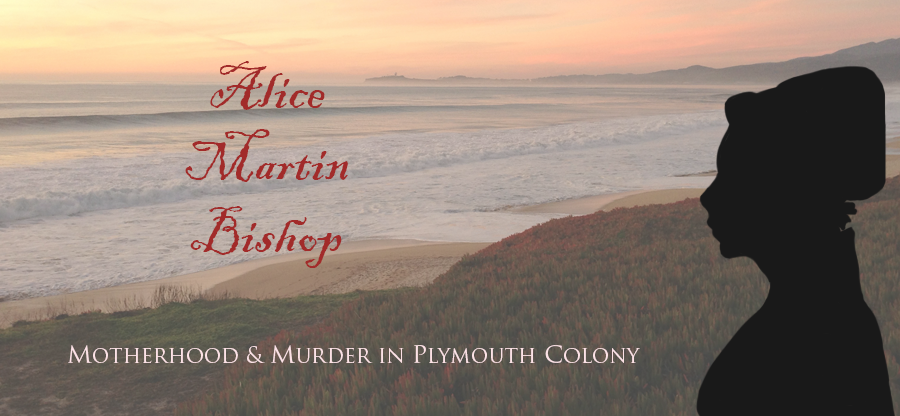Erin Taylor, July 2014
The persistent efforts of judges and ministers to obtain and publish confessions and repentances of the guilty as they stood upon the gallows grew in part from the belief that crimes must not be hidden, even by those about to die.
Peter Hoffer and N.E.H. Hull, 50
Plymouth’s first murder trial was held in 1630 with John Billington accused of murdering John Newcomen. Billington was executed the same year (Philbrick, 157). Similar to Alice Martin Bishop’s (AMB) trial, there was no lengthy investigation-trial-appeal-retrial. Cases were quickly delivered to juries, adjudicated, and if death were called for, there was no need to tarry. However, executions were hardly regular events, for just ten people were executed in the seven decades of Plymouth Colony’s independent existence (Maddox, 252).
Richard Ross writes (of adjoining Massachusetts Bay Colony):
The Massachusetts legal system was not, in the fashion of early modern European polities, a patchwork of numerous and bounded jurisdictions with overlapping responsibilities and clashing agendas. Settlers stripped away much of the complexity that they had known in England and thereby made the machinery for punishing offenders simpler and quicker (986).
With a streamlined system and only one Plymouth citizen with formal legal training (William Brewster, see Murrin 158), justice was quickly determined by Plymouth citizens. Most of these had minimal functional literacy (Murrin, 158) but devotion to the community’s moral codes. Nonetheless, “colonial courts were not concerned with questions of motive, but of fact. The motive of the defendant does not generally appear in records” (Hoffer, 145).
While English law required two witnesses to convict someone of murder, this was obviously not the case for AMB — we had Rachel Ramsden’s “eyewitness” account and AMB’s confession (Philbrick, 195). The coroners are the only additional recorded persons to witness the scene.
The website American Female Hanging reviews the hanging deaths of American women and provides the following insight:
About 500 women have been executed in the United States between 1608 and 1900 with well over 200 hangings for murder, notably infanticide. Historically, women could receive the death penalty for witchcraft, arson and even adultery, although execution was not uniformly imposed.
Hanging may appear a more painless way to die (awful anticipation followed by a quick snap of the neck), but early executioners were often no more than an untrained sheriff or other civil servant tasked with the grim duty. If the “correct drop” was not achieved (by scaffold/tree height, design, knot, rope, and weight of the person), the death may be caused by much slower strangulation. Indeed, after hanging for a time during her execution in 1646 Massachusetts Bay, Mary Martin “spake, and asked what they did mean to do.” Someone adjusted the knot in the rope and she then died (John Winthrop, 1647), but technically, she needed to be hanged twice before her execution was completed. In AMB’s case, she may have well stood on the back of a wagon or placed side saddle onto a horse and dragged off the back by her neck to achieve the hanging from a tree.
The execution likely happened within walking distance of the Plymouth’s town center. If AMB was escorted from a prison, there is some debate on where such a facility would have stood in 1648, although it dates back to at least 1643 (PCR 2:51). William Thomas Davis offers two possible prison sites: one at Summer Street near Market Street, and one near Little Brook (which was also known as Prison Brook) (239 and 254). Davis suggested the area of Alkarmus Hill, “on the westerly side of Sandwich Street” as the “bloody field” in which Plymouth’s earlier hangings may have taken place (149). He also cites that Plymouth had their own Gallows Hill “between Murdock’s Pond and Samoset Street” with Gallows Lane leading to there (151). There are some graves in this vicinity (293). We doubt it took place at the Salem’s Gallows Hill (Brooks, http://historyofmassachusetts.org/where-is-the-real-gallows-hill/) where persons suspected of witchcraft were executed almost 45 years later. Regardless, on the October day AMB was hanged, we imagine the town came out:
Not the least of public entertainment were hangings. Large crowds gathered to watch a culprit turned off and slowly strangled. Such events were frequently hyped by parading the condemned person to public meetings before execution (Ward, 172).
The following is a list of other early colonial women who were executed:
1632: Jane Champion for an unknown offense.
1633: Margaret Hatch in Virginia for murdering her child.
1638: Dorothy Talbye hanged in Salem, Massachussets for infanticide of her three-year-old daughter, Difficulty. Talbye had previously endured a public whipping for attacking her husband and was commonly known to have fallen into an agitated state.
1643: Mary Latham and James Britton were hanged in Massachusetts Bay for adultery.
1647: Mary Martin hanged for infanticide in Massachusetts Bay.
1648: Margaret Jones is one of the earliest women executed for witchcraft in Massachusetts Bay.
1660: Mary Dyer hanged in Boston for refusing to stop practicing her Quaker faith.
1692: Thirteen women were executed or tortured to death, including my great 8x grandmother Martha Allen Carrier, for practicing (or suspicion of) witchcraft in Salem.
